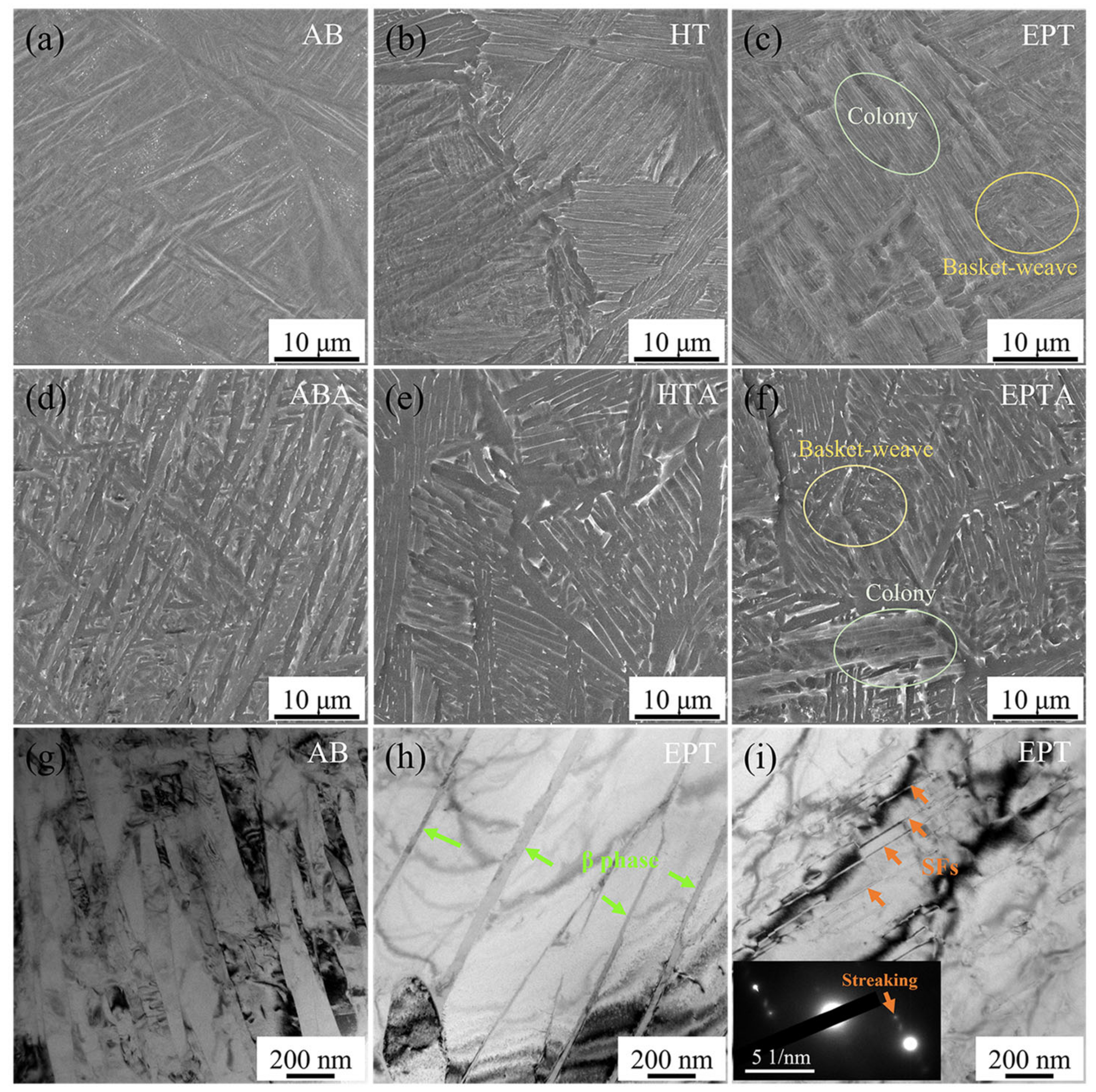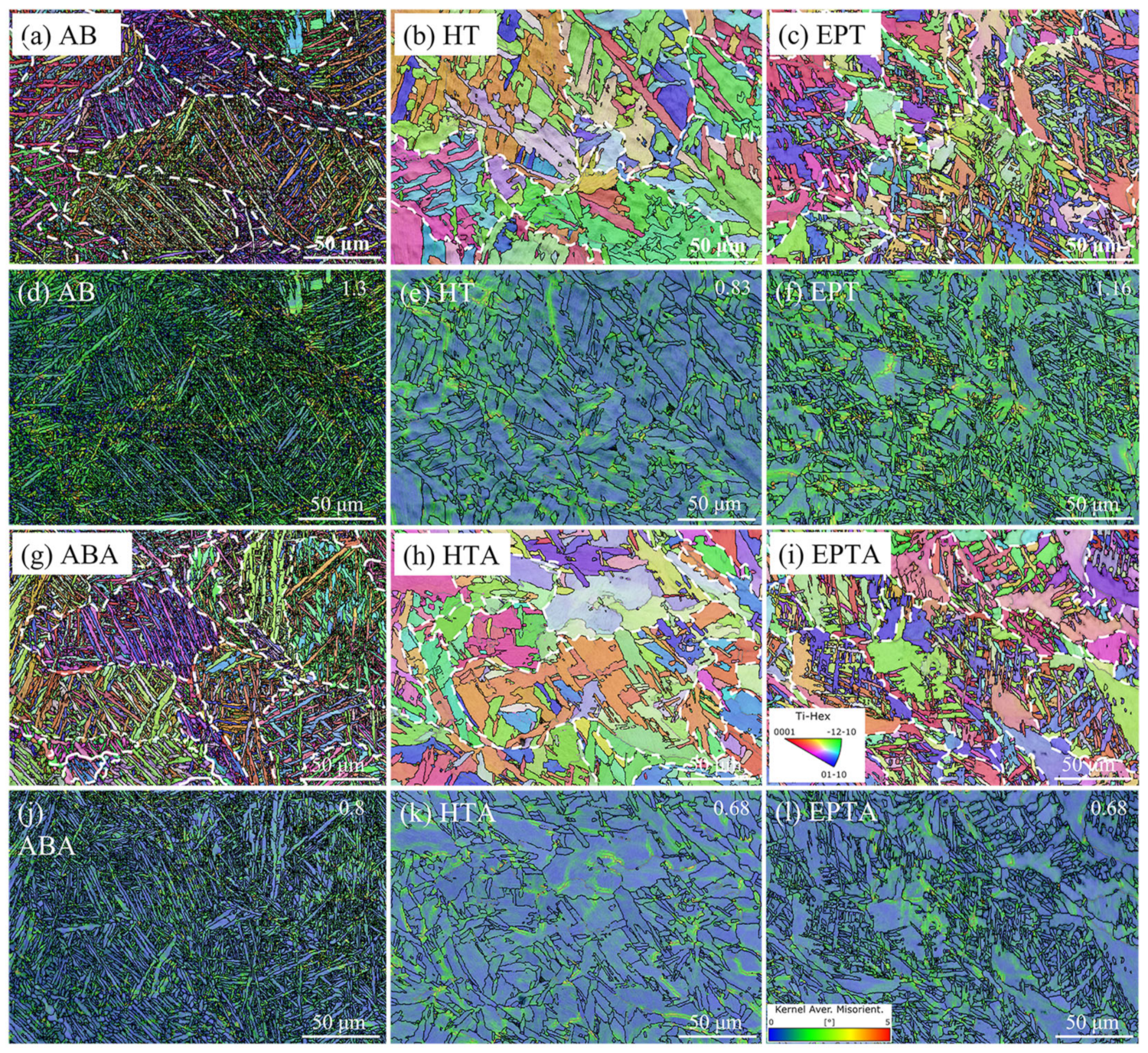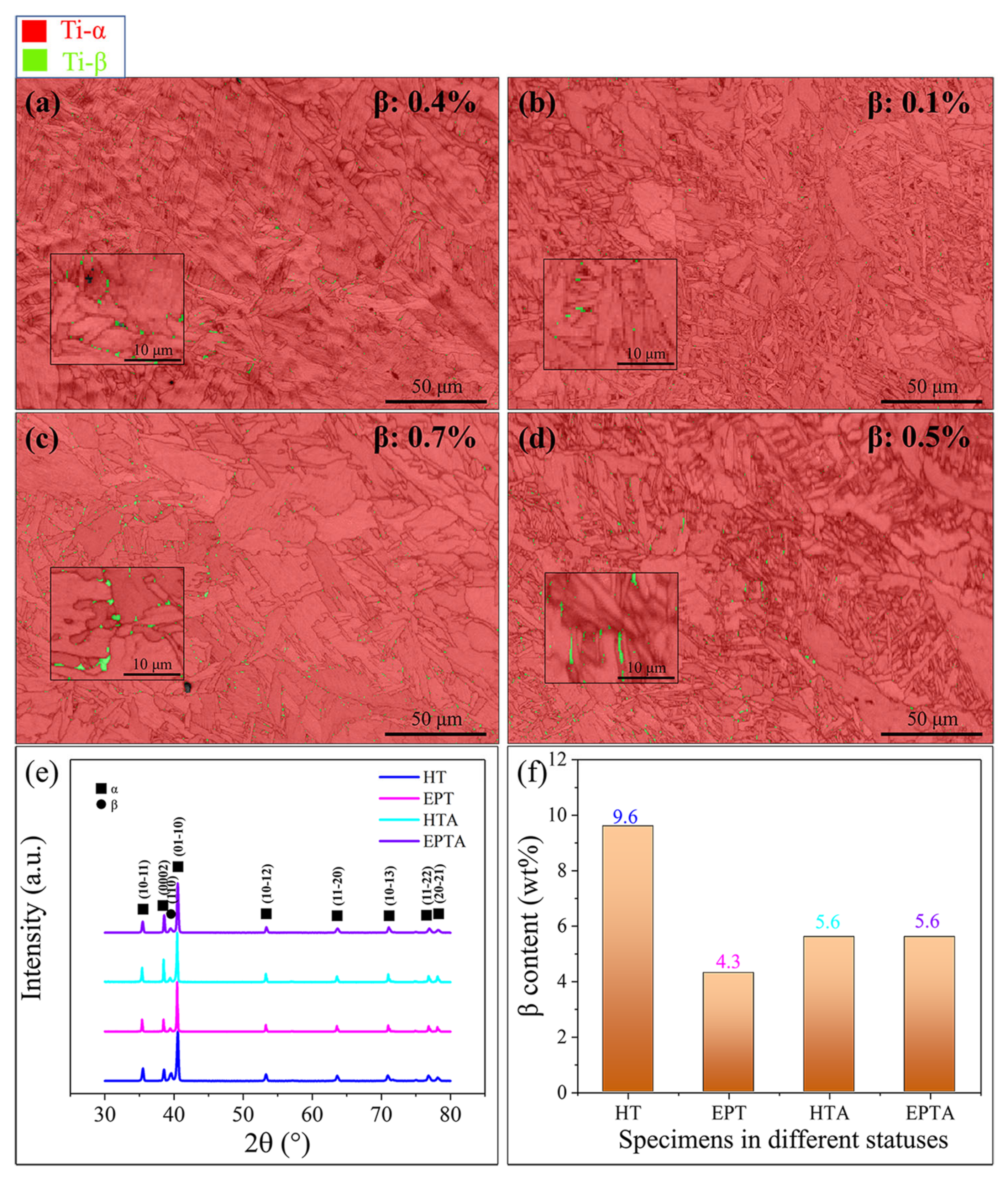High Thermal Stability of a Colony and Basket-Weave Mixed Microstructure in Selective-Laser-Melted Ti-6Al-4V AlloyInduced by Electropulsing
Abstract
1. Introduction
2. Materials and Methods
3. Results and Discussion
4. Conclusions
Author Contributions
Funding
Data Availability Statement
Conflicts of Interest
References
- Lütjering, G. Influence of processing on microstructure and mechanical properties of (α + β) titanium alloys. Mater. Sci. Eng. A 1998, 243, 32–45. [Google Scholar] [CrossRef]
- Rack, H.J.; Qazi, J.I. Titanium alloys for biomedical applications. Mater. Sci. Eng. C. 2006, 26, 1269–1277. [Google Scholar] [CrossRef]
- Liu, S.; Shin, Y.C. Additive manufacturing of Ti6Al4V alloy: A review. Mater. Des. 2019, 164, 107552. [Google Scholar] [CrossRef]
- Vilaro, T.; Colin, C.; Bartout, J.D. As-fabricated and heat-treated microstructures of the Ti-6Al-4V alloy processed by selective laser melting. Metall. Mater. Trans. A Phys. Metall. Mater. Sci. 2011, 42, 3190–3199. [Google Scholar] [CrossRef]
- Kobryn, P.A.; Semiatin, S.L. The laser additive manufacture of Ti-6Al-4V. Jom 2001, 53, 40–42. [Google Scholar] [CrossRef]
- Haubrich, J.; Gussone, J.; Barriobero-Vila, P.; Kürnsteiner, P.; Jägle, E.A.; Raabe, D.; Schell, N.; Requena, G. The role of lattice defects, element partitioning and intrinsic heat effects on the microstructure in selective laser melted Ti-6Al-4V. Acta Mater. 2019, 167, 136–148. [Google Scholar] [CrossRef]
- Yu, H.; Li, F.; Wang, Z.; Zeng, X. Fatigue performances of selective laser melted Ti-6Al-4V alloy: Influence of surface finishing, hot isostatic pressing and heat treatments. Int. J. Fatigue 2019, 120, 175–183. [Google Scholar] [CrossRef]
- Sofinowski, K.; Šmíd, M.; Kuběna, I.; Vivès, S.; Casati, N.; Godet, S.; Van Swygenhoven, H. In situ characterization of a high work hardening Ti-6Al-4V prepared by electron beam melting. Acta Mater. 2019, 179, 224–236. [Google Scholar] [CrossRef]
- De Formanoir, C.; Brulard, A.; Vivès, S.; Martin, G.; Prima, F.; Michotte, S.; Rivière, E.; Dolimont, A.; Godet, S. A strategy to improve the work-hardening behavior of Ti–6Al–4V parts produced by additive manufacturing. Mater. Res. Lett. 2017, 5, 201–208. [Google Scholar] [CrossRef]
- Zhang, D.; Wang, L.; Zhang, H.; Maldar, A.; Zhu, G.; Chen, W.; Park, J.S.; Wang, J.; Zeng, X. Effect of heat treatment on the tensile behavior of selective laser melted Ti-6Al-4V by in situ X-ray characterization. Acta Mater. 2020, 189, 93–104. [Google Scholar] [CrossRef]
- Kim, Y.K.; Park, S.H.; Yu, J.H.; AlMangour, B.; Lee, K.A. Improvement in the high-temperature creep properties via heat treatment of Ti-6Al-4V alloy manufactured by selective laser melting. Mater. Sci. Eng. A. 2018, 715, 33–40. [Google Scholar] [CrossRef]
- Liang, C.L.; Lin, K.L. The microstructure and property variations of metals induced by electric current treatment: A review. Mater. Charact. 2018, 145, 545–555. [Google Scholar] [CrossRef]
- Waryoba, D.; Islam, Z.; Reutzel, T.; Haque, A. Electro-strengthening of the additively manufactured Ti–6Al–4V alloy. Mater. Sci. Eng. A. 2020, 798, 140062. [Google Scholar] [CrossRef]
- Gao, J.B.; Ben, D.D.; Yang, H.J.; Meng, L.X.; Ji, H.B.; Lian, D.L.; Chen, J.L.; Yi, J.; Wang, L.; Li, P.; et al. Effects of electropulsing on the microstructure and microhardness of a selective laser melted Ti6Al4V alloy. J. Alloys Compd. 2021, 875, 160044. [Google Scholar] [CrossRef]
- Wang, F.; Liu, Y.; Tong, Y.; Zhang, C.; Jiang, F.; Wang, J. Effect of electropulsing on anisotropy in strength of laser metal deposited Ti−6Al−4V alloy. Trans. Nonferrous Met. Soc. China 2022, 32, 2578–2586. [Google Scholar] [CrossRef]
- Su, J.; Ji, X.; Liu, J.; Teng, J.; Jiang, F.; Fu, D.; Zhang, H. Revealing the decomposition mechanisms of dislocations and metastable α’ phase and their effects on mechanical properties in a Ti-6Al-4V alloy. J. Mater. Sci. Technol. 2022, 107, 136–148. [Google Scholar] [CrossRef]
- Beladi, H.; Chao, Q.; Rohrer, G.S. Variant selection and intervariant crystallographic planes distribution in martensite in a Ti–6Al–4V alloy. Acta Mater. 2014, 80, 478–489. [Google Scholar] [CrossRef]
- Gupta, A.; Khatirkar, R.K.; Kumar, A.; Parihar, M.S. Investigations on the effect of heating temperature and cooling rate on evolution of microstructure in an α + β titanium alloy. J. Mater. Res. 2018, 33, 946–957. [Google Scholar] [CrossRef]
- Hubbard, C.R.; Snyder, R.L. RIR—Measurement and Use in Quantitative XRD. Powder Diffr. 1988, 3, 74–77. [Google Scholar] [CrossRef]
- Margolin, H.; Izumi, O. Titanium’80: Science and Technology; TMS: Warrendale, PA, USA, 1980. [Google Scholar]
- Semiatin, S.L.; Brown, T.M.; Goff, T.A.; Fagin, P.N.; Barker, D.R.; Turner, R.E.; Murry, J.M.; Miller, J.D.; Zhang, F. Diffusion Coefficients for Modeling the Heat Treatment of Ti-6Al-4V. Metall. Mater. Trans. A 2006, 35, 3015–3018. [Google Scholar] [CrossRef]
- Meng, Y.; Villa, M.; Dahl, K.; Christiansen, T.L.; Somers, M.A.J. Synchrotron X-ray diffraction investigation of the effect of cryogenic treatment on the microstructure of Ti-6Al-4V. Appl. Surf. Sci. 2020, 502, 144087. [Google Scholar] [CrossRef]
- Ghamarian, I.; Hayes, B.; Samimi, P.; Welk, B.A.; Fraser, H.L.; Collins, P.C. Developing a phenomenological equation to predict yield strength from composition and microstructure in β processed Ti-6Al-4V. Mater. Sci. Eng. A 2016, 660, 172–180. [Google Scholar] [CrossRef]
- Ghamarian, I.; Samimi, P.; Dixit, V.; Collins, P.C. A Constitutive Equation Relating Composition and Microstructure to Properties in Ti-6Al-4V: As Derived Using a Novel Integrated Computational Approach. Metall. Mater. Trans. A Phys. Metall. Mater. Sci. 2015, 46, 5021–5037. [Google Scholar] [CrossRef]
- Jun, T.S.; Sernicola, G.; Dunne, F.P.E.; Britton, T.B. Local deformation mechanisms of two-phase Ti alloy. Mater. Sci. Eng. A. 2016, 649, 39–47. [Google Scholar] [CrossRef]





| Yield Strength (YS) (0.2% Offset) [MPa] | Ultimate Tensile Stress (UTS) [MPa] | Elongation (EL) [%] | |
|---|---|---|---|
| ABA | 1002 ± 22 | 1050 ± 9 | 10.7 ± 0.8 |
| HTA | 949 ± 19 | 1019 ± 17 | 10.3 ± 0.8 |
| EPTA | 971 ± 1 | 1049 ± 5 | 14.5 ± 1.4 |
Disclaimer/Publisher’s Note: The statements, opinions and data contained in all publications are solely those of the individual author(s) and contributor(s) and not of MDPI and/or the editor(s). MDPI and/or the editor(s) disclaim responsibility for any injury to people or property resulting from any ideas, methods, instructions or products referred to in the content. |
© 2023 by the authors. Licensee MDPI, Basel, Switzerland. This article is an open access article distributed under the terms and conditions of the Creative Commons Attribution (CC BY) license (https://creativecommons.org/licenses/by/4.0/).
Share and Cite
Wei, L.; Xu, X.; Zhao, Y.; Yan, X.; Zhou, Y.; Wu, Z.; Yu, Y. High Thermal Stability of a Colony and Basket-Weave Mixed Microstructure in Selective-Laser-Melted Ti-6Al-4V AlloyInduced by Electropulsing. Metals 2023, 13, 538. https://doi.org/10.3390/met13030538
Wei L, Xu X, Zhao Y, Yan X, Zhou Y, Wu Z, Yu Y. High Thermal Stability of a Colony and Basket-Weave Mixed Microstructure in Selective-Laser-Melted Ti-6Al-4V AlloyInduced by Electropulsing. Metals. 2023; 13(3):538. https://doi.org/10.3390/met13030538
Chicago/Turabian StyleWei, Lai, Xiaofeng Xu, Yang Zhao, Xudong Yan, Yachong Zhou, Zhicheng Wu, and Yongqiang Yu. 2023. "High Thermal Stability of a Colony and Basket-Weave Mixed Microstructure in Selective-Laser-Melted Ti-6Al-4V AlloyInduced by Electropulsing" Metals 13, no. 3: 538. https://doi.org/10.3390/met13030538
APA StyleWei, L., Xu, X., Zhao, Y., Yan, X., Zhou, Y., Wu, Z., & Yu, Y. (2023). High Thermal Stability of a Colony and Basket-Weave Mixed Microstructure in Selective-Laser-Melted Ti-6Al-4V AlloyInduced by Electropulsing. Metals, 13(3), 538. https://doi.org/10.3390/met13030538





